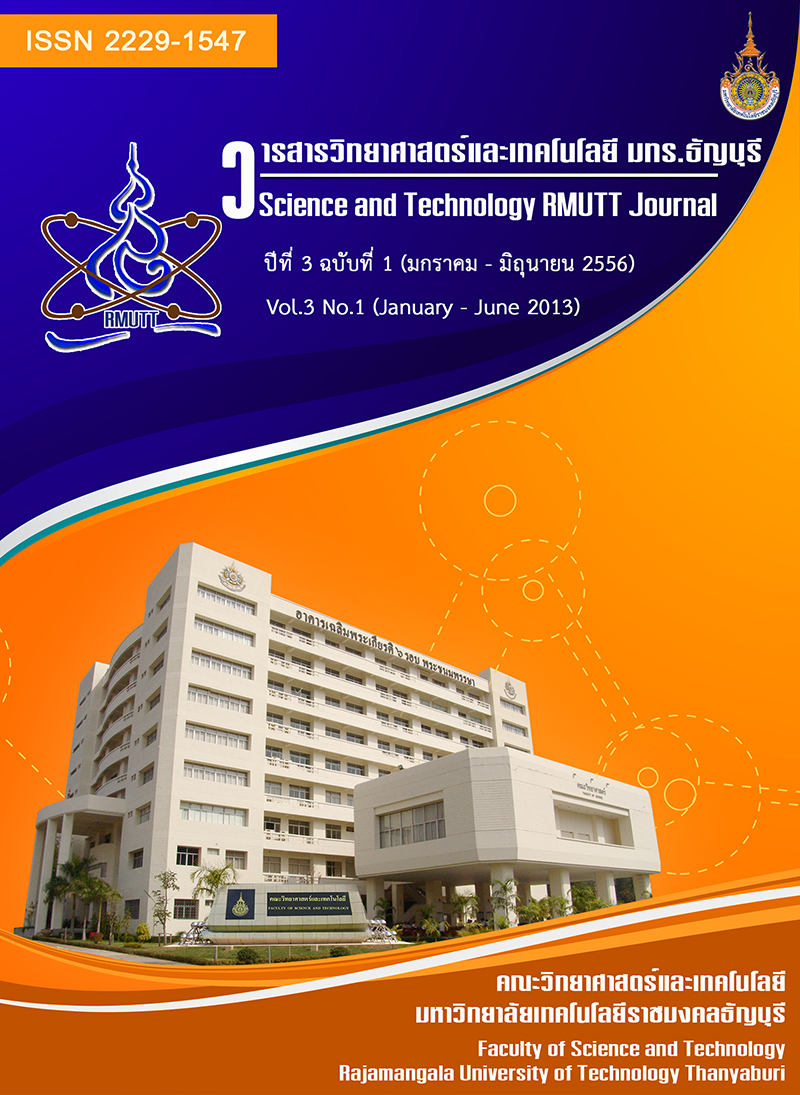Contamination of Escherichia coli and Salmonella sp. inNham (Fermented Pork)
Main Article Content
Abstract
Contamination of Escherichia coli and Salmonella sp. in samples of Nham were studied. All samples were collected during September 2010 to January 2011. The results showed the pH of samples were in the range of 2.3-6.9, samples of Nham were classified into 3 groups according to pH; 1) Nham which have pH lower than standard pH of Nham (2.3-4.3), it will be found 1 sample (5%) in September, 6 samples (30%) in October, 1 sample (5%) in December and 1 sample (5%) in January, 2) Nham which have pH similar to standard pH of Nham (4.4-4.6), it will be found 2 samples (10%) in September, 3 samples (15%) in October, 5 samples (25%) in November, 1 sample (5%) in December and 3 samples (15%) in January, 3) Nham which have pH higher than standard pH of Nham (4.7-6.9), it will be found 17 samples (85%) in September, 11 samples (55%) in October, 15 samples (75%) in November, 18 samples (90%) in December and 16 samples (80%) in January. Nham samples were tested for the total microorganisms count. The results showed the samples gave total microganisms count from 7.0-9.0 log CFU/g which is higher than the microbiological standard level of non-heated processing food. Colifrom and fecal colifrom bacteria were determined in Nham. The percentage of coliform bacteria on September, October, November, December 2010 and January 2011 were 15%, 5%, 15%, 10% and 15% respectively, the fecal coliform bacteria on September, October, November, December 2010 and January 2011 were 70%, 60%, 60%, 65% and 35% respectively. The results showed that amount of these bacteria exceeded the standard level. The biochemical test for fecal coliform bacteria identification, it can be classified as E.coli type II. In addition, Salmonella sp. were also tested, there were found 10% and 5% in September and December respectively, that exceeded the microbiological standard level.
Article Details
References
กองอาหาร กรมวิทยาศาสตร์การแพทย์. 2553. เกณฑ์คุณภาพทางจุลชีววิทยาของอาหารและภาชนะสัมผัสอาหารของกรมวิทยาศาสตร์การแพทย์กระทรวงสาธารณสุข[ออนไลน์]. ได้จาก :
http://www.dmsc.moph.go.th/webroot/BQSF/file/VARITY/cheme/confict22.htm
นงคราญ เรืองประพันธ์ และนิตยา พันธ์บัว. 2535. การสำรวจคุณภาพทางจุลชีววิทยาของแหนมและหมูยอที่ผลิตในจังหวัดภาคเหนือตอนบนของประเทศไทย. วารสารอาหาร. 5 : 32 – 13.
นพมาศ สะพู และรวิวรรณ อาจสำอาง. 2544. การศึกษาการปนเปื้อนของซาลโมเนลลาในแหนม. กรมวิทยาศาสตร์บริการ กระทรวงวิทยาศาสตร์เทคโนโลยีและสิ่งแวดล้อม.
ศิวาพร ศิวเวชช, วิชัย หฤทัยธนาสันต์ และนัยทัศน์ ภู่ศรันย์. 2523. การวิเคราะห์คุณภาพทางด้านจุลินทรีย์ของอาหารบางชนิด จากร้านค้าต่างๆ ในเขตบางเขต. ภาควิชาวิทยาศาสตร์การอาหารคณะเกษตร มหาวิทยาลัยเกษตรศาสตร์.
สุธยา บุญถนอม, ไพโรจน์ วิริยจารี และนินนาท ชินประหัษฐ์. 2537. ผลของโซเดียมไนเตรทและโซเดียมไนไตรท์ต่อคุณภาพแหนมที่ผลิตโดยใช้ Glucono-delta-lactone ร่วมกับเชื้อบริสุทธิ์เริ่มต้น. วารสารเกษตร. ปีที่ 10(3) : 296-312.
สุรีย์ นานาสมบัติ และกัญญารัตน์ จูปรางค์. 2547. ผลการปรับตัวต่อกรดของ Salmonella ssp. ต่อการอยู่รอดในระหว่างการหมักแหนม. วารสารวิทยาศาสตร์ลาดกระบัง. ปีที่ 13(2) : 65 – 77.
อรอนงค์ ไชยเชษฐ. 2548. การสร้างดัชนีคุณภาพจากองค์ประกอบหลักและการยอมรับของผู้ทดสอบชิมของแหนมที่ผลิตในภาคตะวันออกเฉียงเหนือของไทย. วิทยานิพนธ์ปริญญาโท สาขาวิชาเทคโนโลยีชีวภาพมหาวิทยาลัยขอนแก่น.
อรุณ บ่างตระกูลนนท์, นพรัตน์ หมานริม, ชัยวัฒน์ พลูศรีกาญจน์, ปฐม สวรรค์ปัญญาเลิศ และ อดิสรเสว ตวิวัตฒน์. 2547. เชื้อโรคอาหารเป็นพิษในอาหารหมักดองพื้นบ้านพร้อมบริโภค (กุ้งจ่อม ปลาจ่อมปลาร้า ปูดอง). อาหาร FOOD JOURNAL. ปีที่ 34(1) : 90 – 99.
อลิศรา เรืองแสง, รัชฎา ตั้งวงศ์ไชย และอรอนงค์ ไชยเชษฐ์. 2549. ดัชนีคุณภาพของปลาส้มที่ผลิตในภาคตะวันออกเฉียงเหนือของไทย. วิทยาศาสตร์ มก. ปีที่ 24(1-3) : 20 – 36.


